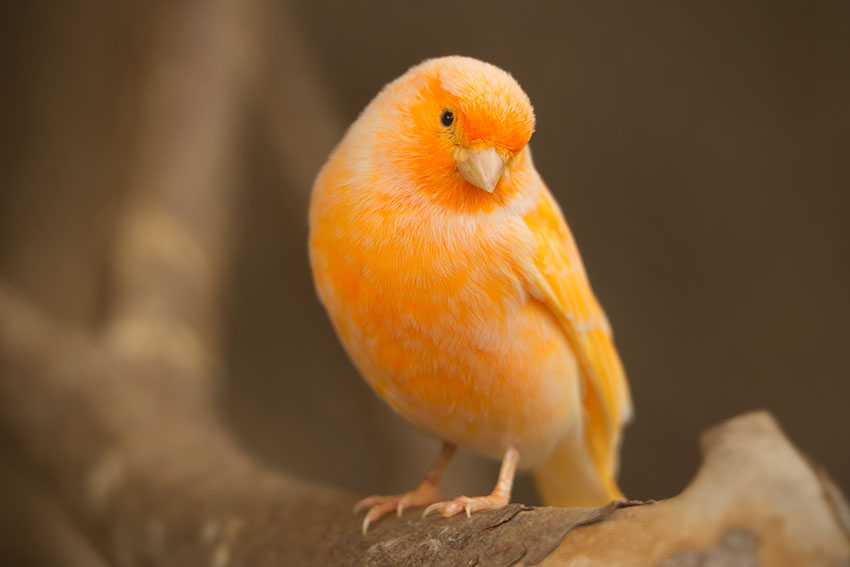Bald Patches
This condition affects the bird’s head and neck usually, (and if baldness appears elsewhere, mites are the likeliest culprits). It’s a symptom of low vitamin D, which the bird can only get from sunlight. Placing the cage near a window for parts of the day (but avoiding direct sunlight if the finch has no shade to retreat to) will help. Some birds are more prone to vitamin D deficiency than others, and will lose their feathers regardless of your attempt to remedy the problem. Many live otherwise happy lives as the odd-one-out with the bald, vulture-like head.
Beak Growth
Abnormal beak growth is rare, but if it strikes it causes a finch’s upper beak to extend like Pinocchio’s nose. The cause is usually dietary (but can, on rare occasions, be due to the Polyoma virus), and you need to make sure the bird is getting enough calcium and other minerals and vitamins. A mineral block permanently available in the cage, along with cuttlefish bone, should sort out the problem. A vet will need to trim the beak, so that the bird can feed properly.
Bone Fractures
An injured bird will have a hanging wing or leg. Finches have very fragile bones, like all birds, and a fit of flapping panic can cause fractures. If a bird is scared in the night it will flap blindly around the cage, and this is often the time when fractures occur. The chances of recovery depend on the severity and position of the break. A vet will apply a splint, and if you’re lucky the finch will be fully mended after a couple of weeks.
Colds and Chills
If there has been a constant fluctuation in room or cage temperature, an excess of damp, or a lot of draughts, finches can suffer what is often referred to as a cold or chill. These problems lower the bird’s immune system, making it more likely to succumb to other diseases. The condition is tricky to diagnose, though, as the symptoms closely resemble many other full-blown infections or viruses – i.e. lethargy, fluffed-up feathers, loss of appetite and loose droppings. If any of the environmental conditions mentioned above apply, it could well be a ‘cold’. The bird will need to be moved somewhere warm, and you should talk to a vet about appropriate antibiotics. You also need to make sure the problems with draught, temperature, etc, are addressed.

Check your birds for signs such as fluffed-up feathers and lethargy
Crop problems
These are commonest among fledgling birds. There are many things that can go wrong – chilly food lodging and turning sour (a condition called ‘sour crop’); crop impaction due to the ingestion of material such as sawdust, grit or paper; or slow crop transit due to dehydration. A vet will recommend a course of action, depending on the condition. This will range from an oral dose of oily liquid, to throat massage, or the crop equivalent of a laxative.
Egg-binding
Also known as dystocia, this is when a bird is unable to lay its egg. Affected hens will squat on the floor of the cage, and show general signs of distress. The condition is brought about by poor diet resulting in a lack of calcium and oil (which a healthy finch derives from oily seeds), and seems most prevalent in cold weather. Prevention, as ever, is the best cure, as you can’t assist an egg-bound bird in laying the egg. Mixing cod liver oil with her usual foods sometimes helps. It’s a bit late to be upping the calcium, but adding crushed eggshells to her feed will do no harm. Some hens die in this state, others eventually pass the egg.
Wounds
Any wound on a bird can become infected and lead to septicaemia (blood poisoning). This will swiftly finish off a finch. If you see any traces of blood on the birds or in the cage, make a visual examination to spot the wounded party. It could be a case of feather bleeding (see Feather Problems, below), but is more likely to be an injury. Any wound should be referred to a vet for antibiotics. Prevention is the best cure for this problem: make sure the cage is free of sharp or pointed objects that could lead to wounds.



Comments
Julie, 12 January 2022
Hi my canary has a bald patch on the left side just above her beak what could this be plz
Tanya, 9 April 2021
My finches have white spot on their beck’s what dose this mean
Karen, 10 March 2019
Our male bird is picking on the back of our females neck and it’s causing a bald spot. So we separated them in different cages so he wouldn’t hurt her anymore. Why has he started to do that to her? She seems hurt and makes a lot of noise and flys away from him when they are in the same cage. Please can you explain why?